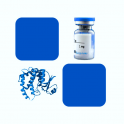
- Remove this product from my favorite's list.
- Add this product to my list of favorites.
Products
Newsletter
 |  |  |  |  |  |

Background
Cluster of differentiation 23 (CD23), also known as Low affinity immunoglobulin epsilon Fc receptor (FCER2), C-type lectin domain family 4 member J (CLEC4J), Fc-epsilon-RII (FcεRII), Immunoglobulin E-binding factor (IGEBF), is the "low-affinity" receptor for IgE, an antibody isotype involved in allergy and resistance to parasites, and is important in regulation of IgE levels. Unlike many of the antibody receptors, CD23 is a C-type lectin. It is found on mature B cells, activated macrophages, eosinophils, follicular dendritic cells, and platelets.There are two forms of CD23: CD23a and CD23b. CD23a is present on follicular B cells, whereas CD23b requires IL-4 to be expressed on T-cells, monocytes, Langerhans cells, eosinophils, and macrophages.[1] CD23 is known to have role of transportation in antibody feedback regulation. Antigen that enters the blood stream is captured by antigen specific IgE antibodies. The IgE immune complexes that are formed bind to CD23 molecules on B cells, and are transported to the B cell follicles of the spleen. The antigen is then transferred from CD23+ B cells to CD11c+ antigen presenting cells. The CD11c+ cells in turn present the antigen to CD4+ T cells, which can lead to an enhanced antibody response.[2] In flow cytometry, CD23 is helpful in the differentiation of chronic lymphocytic leukemia (CD23-positive) from mantle cell leukemia (CD23-negative).[3]
Source
Recombinant Human CD23 / FCER2 Protein (rhCD23), His Tag (CD3-H5249) is expressed from human 293 cells (HEK293). It contains AA Asp 48 - Ser 321 (Accession # P06734-1).
Predicted N-terminus: His
Molecular Characterization
This protein carries a polyhistidine tag at the N-terminus.
The protein has a calculated MW of 32.9 kDa. The protein migrates as 40-44 kDa under reducing (R) condition (SDS-PAGE) due to glycosylation.
Endotoxin
Less than 1.0 EU per μg by the LAL method.
Purity
>95% as determined by SDS-PAGE.
>90% as determined by SEC-MALS.
Formulation
Lyophilized from 0.22 μm filtered solution in 50 mM Tris, 150 mM NaCl, pH7.5. Normally trehalose is added as protectant before lyophilization.
Reconstitution
See Certificate of Analysis for details of reconstitution instruction and specific concentration.
Storage
For long term storage, the product should be stored at lyophilized state at -20°C or lower.
Please avoid repeated freeze-thaw cycles.
This product is stable after storage at:
-20°C to -70°C for 12 months in lyophilized state;
-70°C for 6 months under sterile conditions after reconstitution.
Bioactivity
Please refer to product data sheet.
(1) "Fine needle aspiration cytology of follicular dendritic cell sarcoma of the stomach masquerading as gastrointestinal stromal tumor: A case report of a unique entity with emphasis on cytomorphology"
Shacklette, Chen, DeWitt et al
Diagn Cytopathol (2023)
(2) "Immunophenotypic and genomic landscape of Richter transformation diffuse large B-cell lymphoma"
El Hussein, Medeiros, Lyapichev et al
Pathology (2023)
(3) "Single-cell analysis of human nasal mucosal IgE antibody secreting cells reveals a newly minted phenotype"
Ramonell, Brown, Woodruff et al
Mucosal Immunol (2023)
Showing 1-3 of 3365 papers.
Welcome Login
Contact us
Follow us